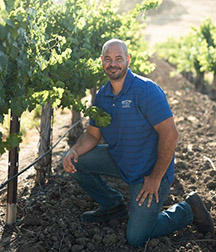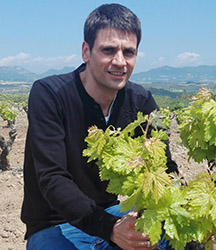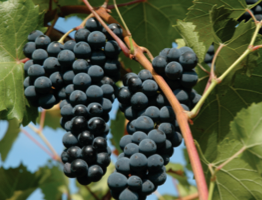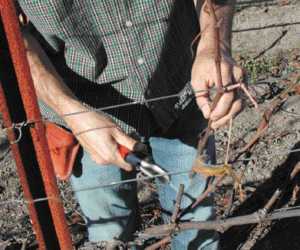Almost all winemakers use oak barrels for aging red and some white wines, as has been the case for ages. However, if you go back far enough, other woods were once common. Even today there are some winemakers who utilize unique woods that bring different characteristics to a wine. This seems like an area ideal for adventurous home winemakers working with smaller batch sizes, less pressure from market demand, and more freedom and flexibility to experiment. To help get us started, we found two pros with experience in this realm and asked for advice.

Sterling Kragten is the Winemaker at Cass Winery in Paso Robles, California.
My first experience with acacia barrels was while I was working at a winery in New Zealand a dozen years ago making Sauvignon Blanc. I continue to experiment with new and different barrels at Cass Winery, and acacia was one that I have really enjoyed using on our Rockin’ One Blanc for the past 10 years. The Rockin’ One is a barrel-fermented and aged white Rhône blend of Roussanne, Marsanne, and Viognier. Of the current 16 barrels for Rockin’ One, eight of the barrels are acacia. The new and “newer” acacia barrels are used on the Viognier part of the blend. The neutral acacia barrels are used on the Marsanne portion of the blend. The Roussanne is aged in oak from the Caucasus Mountains that are seasoned and made in Romania. These barrels are pretty neat too — they are the same species as French oak but grown in a colder climate. This is a tight grain barrel and adds a really cool spice quality to the wine. The acacia barrels are a great complement to this oak barrel because in the end you have a wine with a rich palate of stone fruit with Moroccan spices and floral bouquet. All of these barrels we use for white wine are lightly toasted.
What I really like about acacia barrels is that they contribute the mouthfeel that you expect from barrel aging, but it lifts the varietal aromatics instead of overpowering it with an oak character. I use new acacia barrels on Viognier here at Cass, but I think it would be great on almost any aromatic-driven white wine. Once I retire these barrels for Rockin’ One Blanc I move them to Syrah for another couple years. The first fill of Syrah with these barrels gives it a cool Côte-Rôtie-style Syrah.
Acacia barrels have a little bit thicker staves than traditional oak barrels. The wine does not evaporate nor oxidize as fast as other barrels. This is an especially great benefit to aging white wine. Comparing acacia to oak in terms of longevity is more difficult to determine. Currently, the oldest acacia barrel on the Rockin’ One is six years old. Not only does the acacia have more of a subtle quality than that of a traditional oak barrel, but since this wine is fermented in barrel, the ferment will “eat through” (so to speak) the toasted part of the barrel. Also, these whites get filled every year. The Rockin’ One Blanc is aged for 10 months, where our typical reds are close to two years. So, all this is to say the white wine barrels have less longevity — and the acacia may be less so — but they made great neutral barrels.
As far as Cass wines go, acacia will only be a complementary part of a blend. But if I had the time, capacity, and capital to make all the wines I want (more than the couple dozen wines I already produce), then a 100% Viognier in new acacia barrels would be pretty cool and especially tasting side-by-side to my stainless-steel Viognier.
For home winemakers, I don’t think that an acacia stave or other type of addition to the wine would necessarily give the character that I am looking for. Although, I believe you can buy smaller format barrels, which would be fun to try!

Diego Orio is the Winemaker at Bodegas Tobía S.L. in La Rioja, Spain
We did a research project in conjunction with a cooperage here in La Rioja to see how white wine behaved in different wooden containers. Different types of wood were used: Chestnut, ash, cherry, American oak, French oak, and Hungarian oak. After these years of testing and experience, we could summarize, generalizing a lot, the behavior of the different woods as follows:
French oak: Brings subtlety, elegance, and complexity to wine. Often contributes notes of spice, clove, nutmeg, vanilla, tobacco, cocoa, and toast. The tannins integrate harmoniously with the wine, providing structure, balance, and fullness in the mouth.
American oak: Contributes notes of coconut, vanilla, dill, toffee, and peppery spices. The wood can be more evident in the flavor profile, bringing a distinctive character to the wine. It is a less tannic wood than French and therefore finer.
Hungarian oak: Similar to French oak, but very respectful of the wine’s fruit and provides a lot of aromatic freshness and balsamic notes.
Quercus pyrenaica oak: Enhances the freshness on the nose, increasing the intensity of fresh fruit aromas. And with more vigorous and pronounced tannins.
Acacia: Used entirely in the production of white wines, acacia wood provides very soft and mellow tannins, very characteristic aromas, and a golden yellow color. We continue to use a small percentage of acacia at Bodegas Tobia.
Chestnut: Sweet aromas and flavors, with hints of nuts. Good-quality tannins. Very similar to the profile of French oak.
Ash: The aromas contributed to the wine by this alternative species are balsamic and toast. Despite the predominance of vanillin, it is not one of the main aromas noted in the sensory analysis of wines aged with this wood.
Cherry: It brings to the wine notes of red fruits and some toasted notes of great quality. Cherry is very porous so care must be taken when using it as a barrel for aging to avoid oxidation.







